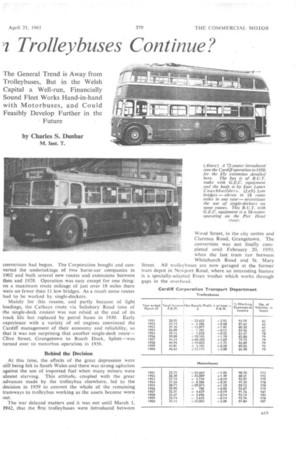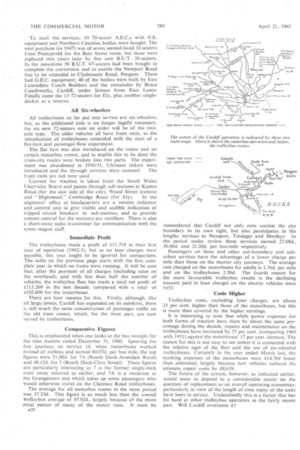Can Cardiff's Confidenc
Page 52

Page 53

Page 54

If you've noticed an error in this article please click here to report it so we can fix it.
Trolleybuses Continue?
The General Trend is Away from Trolleybuses, But in the Welsh Capital a Well-run, Financially Sound Fleet Works Hand-in-hand with Motorbuses, and Could Feasibly Develop Further in the • Future by Charles S. Dunbar
M. Inst. T.
0 N financial and operational grounds there appears to be no reason why Cardiff Corporation should not continue and even, perhaps, further develop its trolleybus system, especially as most of the current vehicles and much of the equipment are not near the end of their life. But there is one very cogent reason why this may not happen. They claim a certain amount of difficulty in obtaining suitable replacement vehicles. There are only two suppliers—B.U.T. and Sunbeam. If this were not so there can be little doubt that this well-run system could be expected to continue for many years. It will be a great pity if the trend away from trolleybuses elsewhere forces Cardiff Corporation's hand and leads eventually to abandonment. .
As recently as 1955 Cardiff showed its confidence in the trolleybus when on May 8 of that year, it extended the Victoria Park line to Ely, thus adding 4.3 route miles to the electrical system. Motorbus routes 27A and C were withdrawn and replaced by trolleybuses 10A (Wood Street-Green Farm Road, out via Grand Avenue, returning via Cowbridge Road) and 10B, which works the other way round.
Full Trolleybus Service
This meant that practically the whole service to Ely was turned over to trolleybuses, as 10B gives a 7-minute peak and 10-11-minute off-peak service, and 10A a 17-18-minute service, compared with five journeys a day on 27 to St. George's and an approximately hourly service on 27D which serves both Cwrt-yr-ala Road and Culverhouse Cross. The Heol Trelai service, 27B, on which there is a 12-minute headway, only covers part of the Cowbridge Road and does not run into the city but feeds the trolleybuses at Victoria Park.
The conversion of the Ely route called for an additional 13 trolleybuses but 16 motorbuses were taken off and used to replace obsolete vehicles elsewhere. There was a net reduction in the total fleet as a result.
a18
When Cowbridge Road was widened in the '20s much ol it was laid out with a central reservation for trams but the extension was never made. The reservation, however, came in handy for laying the trolleybus cables.
The electric service has been popular and successful. From April 1 to December 31, 1960, its receipts per busmile were 52.37d. Although this was not the highest on the system it was well above the average for all trolleybus routes of 47.93d., and particularly good in view of the mainly suburban area served, with little off-peak traffic.
The original introduction of trolleybuses into Cardiff resulted from a complete change of policy after tram
conversion had begun. The Corporation bought and converted the undertakings of two horse-car companies in 1902 and built several new routes and extensions between then and 1928. Operation was easy except for one thing: on a maximum route mileage of just over 18 miles there were no fewer than 11 low bridges. As a result some routes had to be worked by single-deckers.
Mainly for this reason, and partly because of light loadings, the Cathays route via Salisbury Road (one of the single-deck routes) was not relaid at the end of its track life but replaced by petrol buses in 1930. Early experience with a variety of oil engines convinced the Cardiff management of their economy and reliability, so that it was not surprising that another single-deck routeClive Street, Grangetown to Roath Dock, Splott-was turned over to motorbus operation in 1936.
Behind the Decision At this time, the effecrts of the great depression were still being felt in South Wales and there was strong agitation against the use of imported fuel when many miners were almost starving. This attitude, coupled with the great advances made by the trolleybus elsewhere, led to the decision in 1939 to convert the whole of the remaining tramways to trolleybus working as the assets become worn out.
The war delayed matters and it was not until March 1, 1942, that the first trolleybuses were introduced between
Wood Street, in the city centre and Clarence Road, Grangetown, The conversion was not finally completed until February 20, 1950, when the last tram ran between Whitchureh Road and St. Mary Street. All trolteybuses are now garaged at the former tram depot in Newport Road, where an interesting feature is a specially-adapted Essex washer which works through gaps in the overhead. To start the services, 10 70-seater A.E,C.s with E.E. equipment and Northern Counties bodies were bought. The next purchase (in 1947) was of seven second-hand 32-seaters from Pontypridd for the Bute Street route, but these were replaced two years later by five new B.U.T. 38-seaters. In the meantime 50 B.U.T. 67-seaters had been bought to complete the conversion and to enable the Newport Road line to be extended to Clydesmuir Road, Pengam. These had G.E.C. equipment; 40 of the bodies were built by East Lancashire Coach Builders and the remainder by Bruce Coachworks, Cardiff, under licence from East Lancs. Finally came the 13 72-seaters for Ely, plus another singledecker as a reserve.
All Six-wheelers All trolleybuses so, far put into service are six-wheelers,'but, as the additional axle is no longer legally necessary, the six new 72-seaters now on order will be of the twoaxle type. The older vehicles all have front exits, as the introduction of trolleybuses coincided with the start of a flat-fare and passenger-flow experiment.
The flat fare was also introduced on the trams and on certain motorbus routes, and to enable this to be done the cross-city routes were broken into two parts. The experiment was abandoned in 1950.-51, Ultimate tickets were introduced and the through services were restored. The front exits are not now used.
Current for traction is taken from the South Wales Electricity Board and passes through sub-stations at Karnes Road -(for the east side of the city), Wood Street (centre) and •"Highmead," Cowbridge Road (for Ely). In the engineers office at headquarters are a remote indicator and control unit to give visible and audible indication of tripped circuit breakers in sub-stations, and to provide remote control for the mercury-arc rectifiers. There is also a short-wave radio transmitter for communication with the tower-wagon staff.
. Immediate Profit The trolleybuses made a profit of £11,718 in their first year of operation (1942-3), but as no loan charges were payable, this year ought to be ignored for comparison. The table on the previous page starts with the first complete year in which no trams were running. It will be seen that, after the payment of all charges (including rates on the overhead), and with less than half the number of vehicles, the trolleybus fleet has made a total net profit of £113,269 in the last decade, compared with a total of £105,609 for the motorbuses.
There are four reasons for this. Firstly, although, like all large towns, Cardiff has expanded on its outskirts, there i. still much the same concentration of passenger traffic on the old tram routes, which, for the most part, are now served by trolleybuses.
Comparative Figures This is emphasized when one looks at the bus receipts for the nine months ended December 31, 1960. Ignoring the few journeys on service 16, when motorbuses worked instead of trolleys and earned 60.07d. per bus mile, the top figures were 51.08d. for 7A (Roath Dock-Avondale Road) and 48.12d. for 7 (Roath Dock-Clive Street). These figures are particularly interesting as 7 is the former single-deck tram route referred to earlier, and 7A is a variation at the Grangetown end which takes up some passengers who would otherwise travel on the Clarence Road trolleybuses.
The average for all motorbus routes in the same period was 37.23d. This figure is so much less than the overall trolleybus average of 47.92d., largely because of the more rural nature of many of the motor runs. It must be D20 remembered that Cardiff not only runs outside the city boundary in its own right, but also participates in the lengthy services to Newport, Tredegar and Merthyr. In the period under review these services earned 27.68d., 30.06d. and 21.20d. per bus-mile respectively.
Passengers on these and other out-boundary and suburban services have the advantage of a lower charge per mile than those on the shorter city journeys. The average rate charged on the motorbuses for adults is 1.76d. per mile and on the trolleybuses 2.30d. The fourth reason for the more favourable trolleybus results is the declining amount paid in loan charges on the electric vehicles since 1955.
Costs Higher Trolleybus costs, excluding loan charges, are about. 25 per cent, higher than those of the motorbuses, but this is more than covered by the higher earnings.
It is interesting to note that while power expenses for both forms of traction have risen by about the same percentage during the decade, repairs and maintenance on the trolleybuses have increased by 55 per cent, (comparing 1960 with 1951) against the motorbuses' 17 per cent. increase. The reason for this is not easy to see unless it is connected with the relative ages of the fleet and the use of six-wheeled trolleybuses. Certainly in the year ended March last, the working expenses of the motorbuses were £14,769 lower than estimated, largely because new vehicles reduced the estimate repair costs by £8,639.
The future of the system, however, as indicated earlier, would seem to depend to a considerable extent on the question of replacement as on overall operating economics, particularly in view of the length of time many of the units have been in service. Undoubtedly this is a factor that has hit hard at other trolleybus operators in the fairly recent past. Will Cardiff overcome it?




















































































































